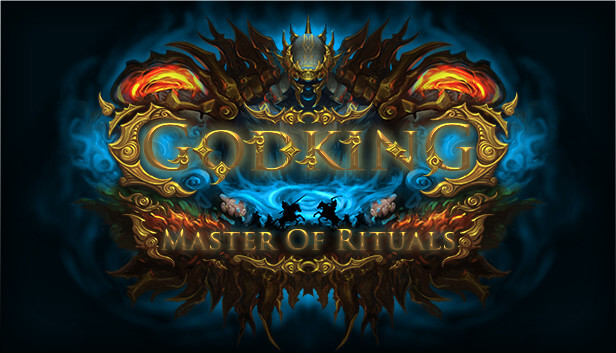WHAT TO EXPECT: Fantasy 4X turn-based strategy. Basic global maps. Command a single capital city. Capture neutral or enemy settlements. Automated turn-based battles. Impressive range of warrior gods. Decent number of factions with good variety. Good-sized champion led armies. Dozens of derivative unit classes. Numerous commander types. Two spells types and artefacts to equip. Basic 4x gameplay. Units can level-up. No diplomacy. No tech research. Missing a load of QoL. Single-player only.
ACHIEVEMENTS: NONE.
STATUS: RELEASED PREMATURELY OUT OF STEAM EARLY ACCESS.
WHEN TO BUY: ONLY IF LOOKING FOR CASUAL OR LITE 4x.
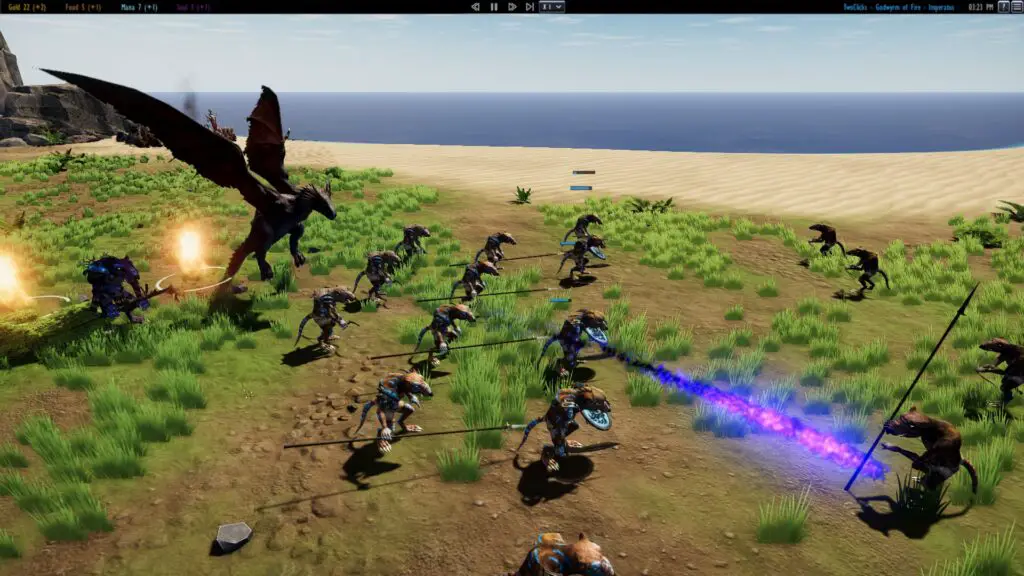
Godking: Master of Rituals (G:MoR) is a turn-based 4x strategy game with automated battles fought on anonymous battlefields between opposing armies. The game is set in a fantasy land and played on a dynamically generated, hex-tiled world map. Before beginning each game players must set-up the game world; opting for a faction to play and a warrior God to lead them. There are three map sizes to choose from. Eight factions with their own unit classes and nine unique warrior gods to take charge of.
Gameplay follows the basic tenets of 4x games. Protect a capital city, the hub of each empire and vanquish every other faction on the map. Every turn up to four resources are acquired and used in construction of capital upgrades or to recruit more units and commanders. Armies are formed by assigning a commander to lead them. These are sent to explore the immediate vicinity and reveal what lies within the fog of war. Their aim is to discover neutral or enemy settlements, so these can be conquered and to uncover the activities of the enemy. To eventually expand the empire and gain more resources per turn to purchase further capital upgrades, units and commanders. With stronger forces the empire can then exploit these gains, build larger armies and eventually go on to exterminate their rivals.
Automated-combat takes place when two rival armies occupy the same hex on the map at the end of a turn. When the view switches to that of a 3D battlefield each side takes turns moving towards the other. Firing ranged weapons and casting magic spells when in range. Temporary allies can be summoned. Engaging in melee when one side reaches the other. Turns occur sequentially using WEGOUGO until all units from one side are slain. The victor of such battles sometimes receives artefacts, items that can be equipped by commanders that increase their capabilities. Those units that remain alive also gain experience and can level in power and abilities. This continues until all other enemies armies have been extinguished and their capitals conquered.
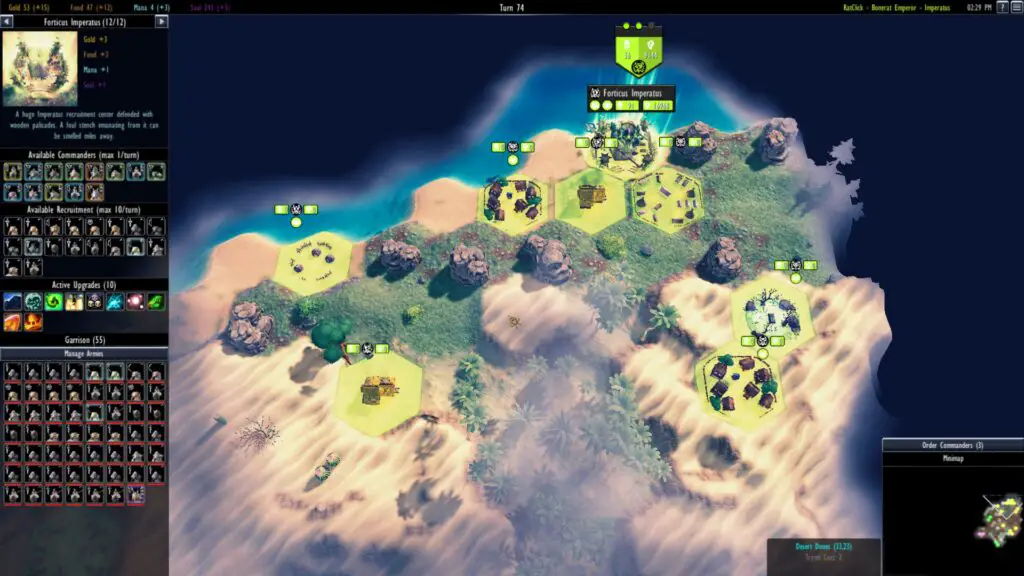
THE GOOD:
- Good replayability with 8x unique playable factions, each with their own set of units, spells and playable strategies.
- Detailed combat engine with movement by ranks, spell-casting, ranged attack and melee combat.
- Visually beautiful automated combat with colourful 3D models. Minimal battlefield landscapes.
- Good army composition options. Units types are mounted, ranged, can fly, cast spells, melee, extended melee and temporary allies that can be summoned.
- Soundtrack that adds to the general ambience.
THE BAD:
- No combat interaction. None at all.
- Missing feature: No diplomacy.
- Missing feature: No research/research tree.
- Needs alot of QoL: artefact and army distribution, more options on army formation screen, controlling multiple commanders in same army is problematic.
- Poor map movement. Units move one tile at a time. Cannot set movement paths or undo moves on world map.
- Basic enemy AI. Built just to provide an obstacle to victory. Performance issues. PC noticeably slows down when running the game. Core i5 8GB ram.
- GUI suffers from terrible scaling. Need perfect vision to read some of the text.
- No game setup randomiser.
AND THE REST:
- The beginnings of a good 4x fantasy experience.
- Randomly generated maps with randomly placed holdings, defences?, magical artefacts, treasure chests and wandering monsters.
- Ten unique God-like incarnations. Each with their own passive abilities, combat stats, spells and strategies. Can be used in conjunction with any faction, providing the only real replayability.
- Large selection of magic spells divided into Rituals and Combat. Comparable to techs but not requiring research.
- Ten capitol upgrades. Unlocked sequentially when certain upgrades are built. Also unlock new units and commanders for recruitment.
- Basic army formation screen that separates units into ranks and allows transfer from one group to another.
- Large number of artefacts that drop during combat. Equipped on commanders and warrior-gods to augment stats.
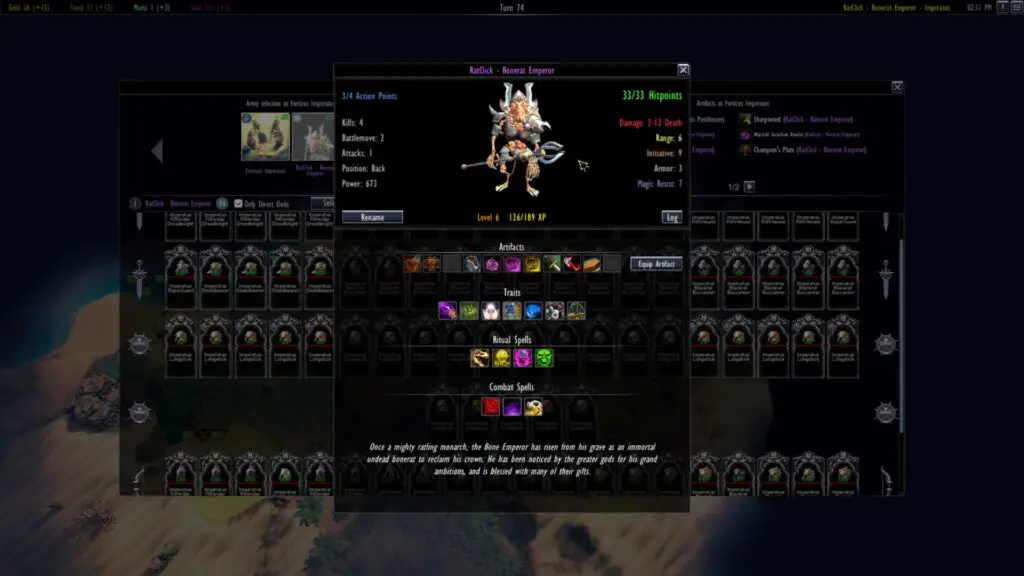
ANALYSIS:
G:MoR turned out to be a visually impressive game. One built on a solid concept but a flawed execution. Lacking some of the detailed features associated with the 4x genre. A likely consequence of the devs striving for streamlined gameplay. Though it is difficult to know for sure what the roadmap entailed, had it not left EA so early. Given its current state anyone expecting G:MoR to retain a good level of depth and complexity, may be more than disappointed. It combat centric in its approach eventually becomes very repetitive.
Overall the game painted a mixed picture of the experience that awaited players. An automated combat system looked substantial, but little else did. Ritual spells, combat spells, factions, commanders and artefacts all showed signs of being fleshed out. As was Army management and the unit roster. Game setup was thread-bare. Diplomacy and research were non-existent. Joining a below par GUI requiring a fair amount of additions, particularly scaling to make the text readable. All the missing functionality pointed to an incomplete game, released too early. Likely another case of the developers running out of funds, time or both. Yet on some level there is a playable game here. Just not one that should necessarily be called 4x strategy. Maybe 4x strategy lite would be a better fit!
Game set-up proved to be basic. The amount of starting factions and warrior gods were acceptable out of the box. Distinct in nature and possessing the strengths and weaknesses to have their own particular strategy or play-style. Enough to persuade players to try each of them. Particularly pleasing were how warrior gods could be mixed and matched with whichever faction was preferred. Rather than stay with their own race. Factions also had their own resources to cultivate. Though why other factions did not gather these, so they could be appropriated after a defeat escaped me. A randomising option would have been most welcome.
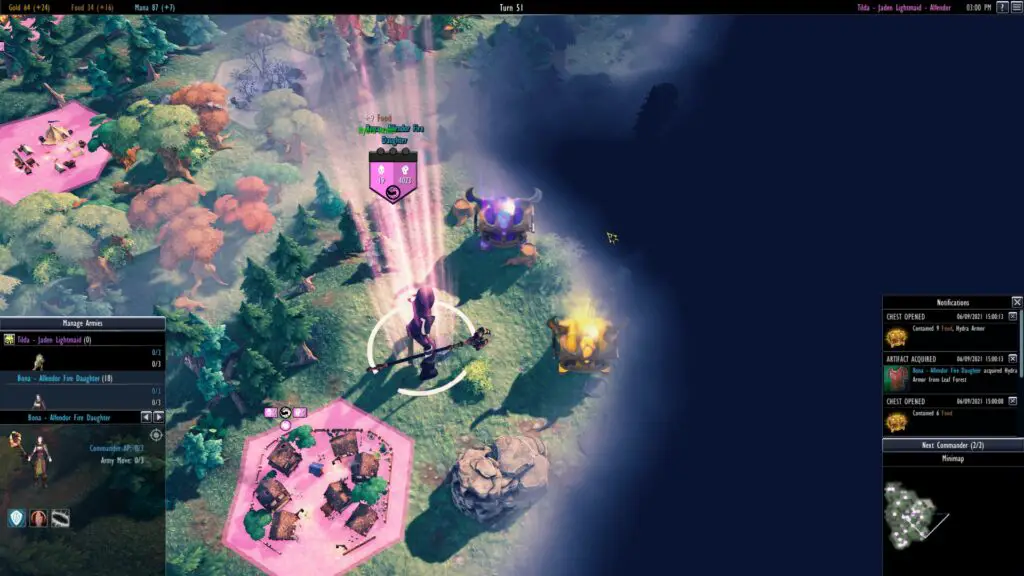
Initially the global map appeared devoid of activities to conduct. Limited to moving armies to scout nearby territory, to engage hostile armies and to protect or wrestle control of settlements. At least one faction was able to build settlers to create additional farms. Though other nations would need to relying on just conquering rather than building these. There were also treasure chests to loot containing artefacts or resources. Even so most of the map was filled with independent factions. Put there one would guess just to be conquered. A genuine surprise saw an independent unit persuaded to join the ranks of my army. So there were things to do. Perhaps not enough for my demanding expectations. Dynamic events affecting specific areas, armies or hexes would have been a welcome addition, keeping players somewhat more on their toes.
City management was virtually non-existent. Constructing capital upgrades the only function to manage. An instantaneous process with up to twenty upgrades to construct per faction. Often less. These would be accomplished quickly enough. Leaving little else to worry about except the business of managing armies, ferrying replacements and artefacts, and conquering settlements one at a time. The only constant strategic concern was the quandary of which neutral settlements to capture and which ones to allow the enemy to re-take when threatened by sizeable forces. Many more features were needed here. Raising defensive levels for instance. Imagine a city’s defence level reaching five and seeing associated structures reflected in the battlefield generated, when said city was under attack.
Even in this state the combat system shone. There were tons of unit models rendered in wonderful colour and 3D. Commanders and warrior gods that stood out amongst the other ranks. Animations and combat flow that were enjoyable to watch. Even for someone who is not the greatest fan of automated combat. However for a game lacking so many other, more important features it ended up feeling gimmicky. After the first dozen battles it was simply more prudent to hit the accelerate key and go directly to the results screen. It could have been something greater with a little more imagination to allow players some interaction between turns.

Army management was functional, allowing units to be moved from one army to another. The same for artefacts from one commander to next. These needed to be built upon. At least there was a formation system that organised armies into ranks by unit type. Yet this needed to be built upon. Dividing ranks into flanks and allowing players to issue hands-off orders to individual flanks. Positioning commanders or attaching them to rank and/or flank. To give the AI some scope as to how it should behave in certain situation. Ordering a retreat having lost x% of the force. To flank on one side or the other. Perhaps prioritising commander spells or, giving flanks or ranks specific objectives. Anything tactical in nature to break the monotony of watching a video of unfolding events. The game even hinted at having some sort of morale system but no solid demonstration ever materialised apart from casters sending enemies fleeing with fear spells.
The derivative nature of units was softened by a combination of traits, artefacts and levelling battle-hardened warriors really distinguished a player’s forced, given time. Even if units traits just seemed to be unearned in nature. A missed opportunity would have been to have city buildings apply stat bonuses or additional traits. Maybe even having the option to add these only on levelling. The true differences in units came across factions with monsters, flying creatures and mounted creatures joining the hordes of spell-casters and bipedal humanoid forms. All forms impressively rendered in 3D and brightly coloured. Something that should be echoed once more.
There were no research or diplomacy systems. Two major features that may have been pencilled in for addition during Early Access. The closest things to techs, being the many unique magic spells available. Rituals were spells available to commanders and gods belonging to specific factions. They could serve many functions from; summoning temporary allies, generating extra resources, increasing spotting/detection, trading, defensive structures, unit promotion, creating artefacts, teleporting to the capital or regenerating health. The commanders recruited the more spells could be cast. This was a good feature but under-utilised for alot of the game. Combat spells were specific to units.
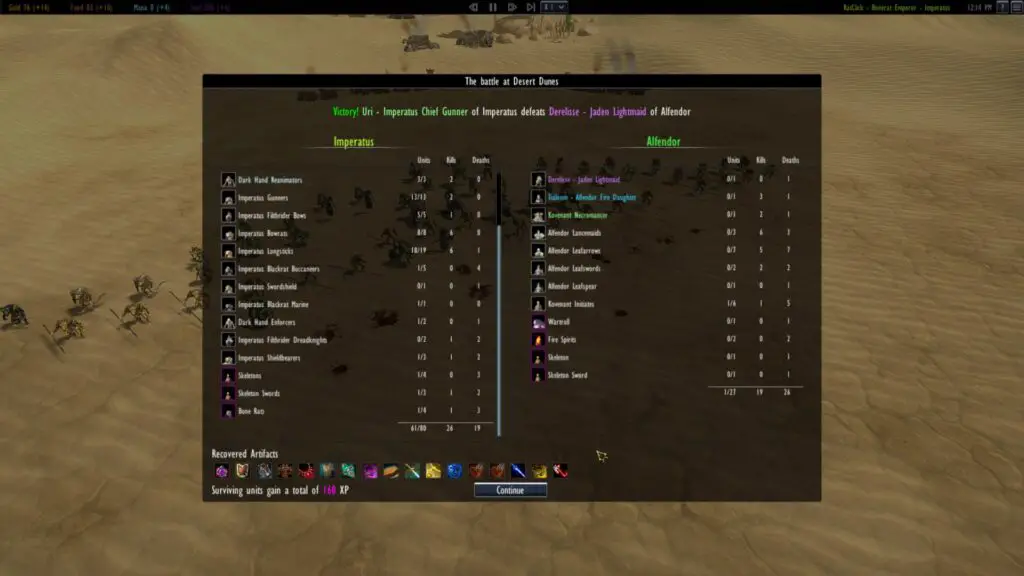
Without a diplomacy system all factions on the map were constantly at war. Providing no chance of respite if the AI were to gain the upper hand. Which was unlikely to happen as the AI seemed to be arranged to provide the fodder for battles. Something it did aptly without aplomb. The only concern a player would have would be if they were unlucky enough to move their best army into range of an enemy army that was more powerful. All in all this was a real disappointment.
Still the lack of micro-management was a bonus and may encourage gamers looking for a more casual combat-oriented 4x to try this. It has a decent level of QoL but needed alot more. Game balance is a mixed bag. Worse in terms of factions, despite making them individual in nature and encouraging players to try out each faction. Possibly contributing to an more unique experience with each one. The reality though is that strategy was insufficient for such a genre. Almost certainly most of it was focused on deciding which units to buy and which route for the army to take across the board.
VERDICT:
Godking: Master of Rituals has a little to offer someone looking for a turn-based, fantasy strategy experience. Unfortunately there does not seem enough for a full game in the 4x genre. With a good deal of features missing it is pretty fair to make the assumption that G:MoR was released to get something playable out of the door. Likely due to time or funding running out. What features are included show a potential platform for what could have been a very good fantasy themed 4x strategy game. Instead what is there is a lite version focused on delivering its strategy challenge mostly through its combat and little elsewhere.
I liked G:MoR but there are just better games in this genre out there. It is truly disheartening to compare the potential of this version, to what content there actually is. So unless looking to play a polished beta release that is purely combat focused, this is a FORGETTABLE title. One that just isn’t easy to recommend.


